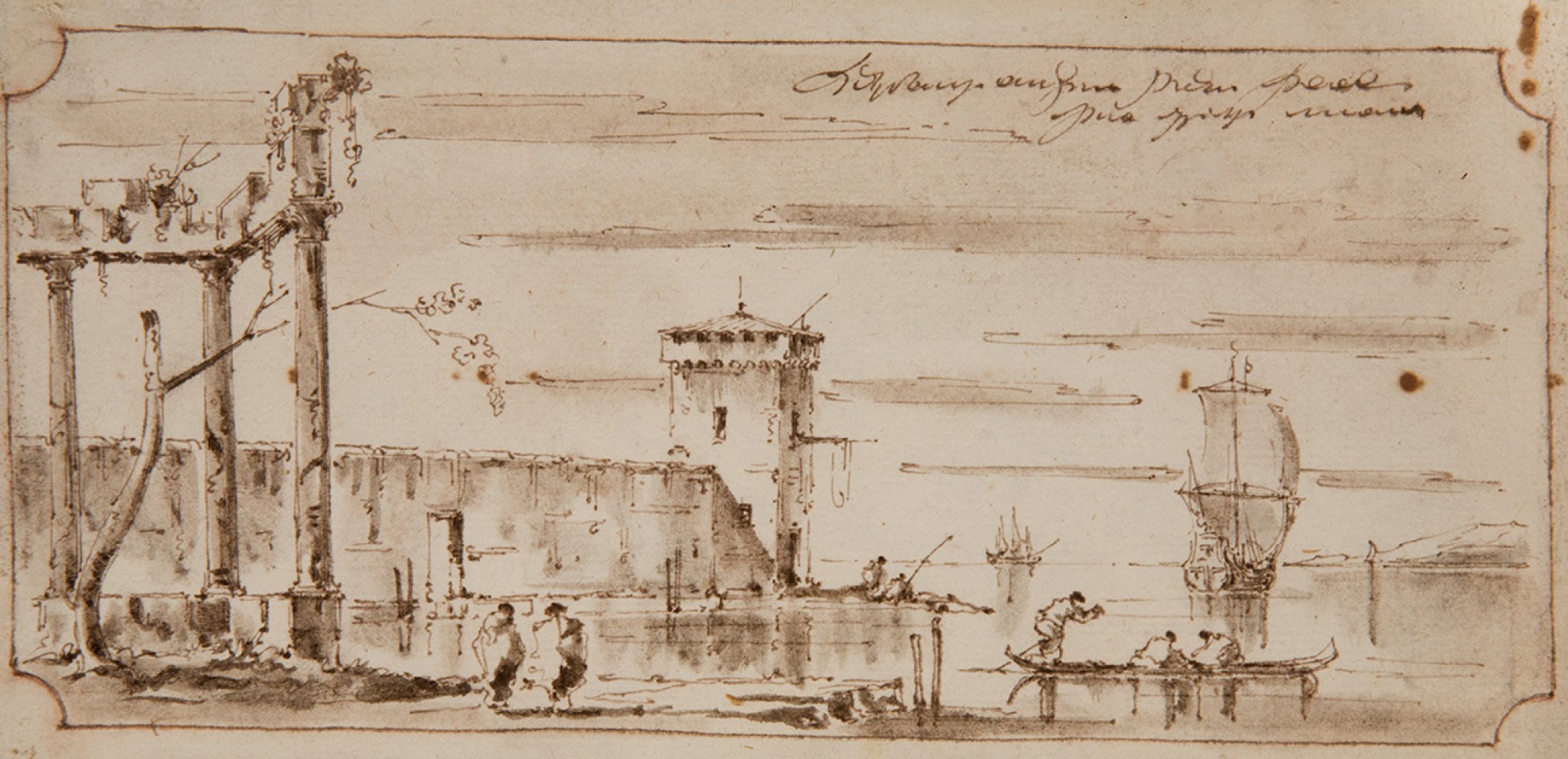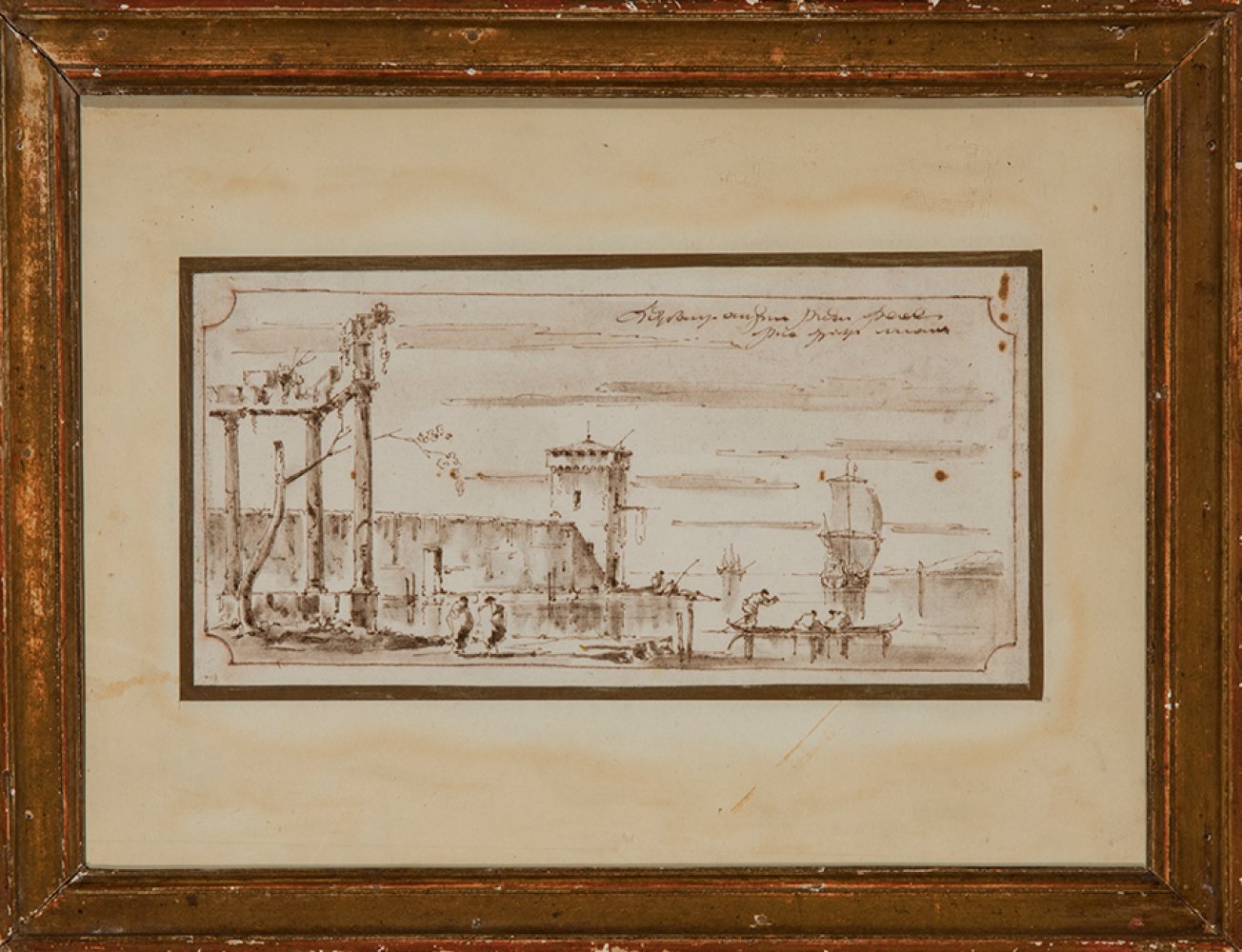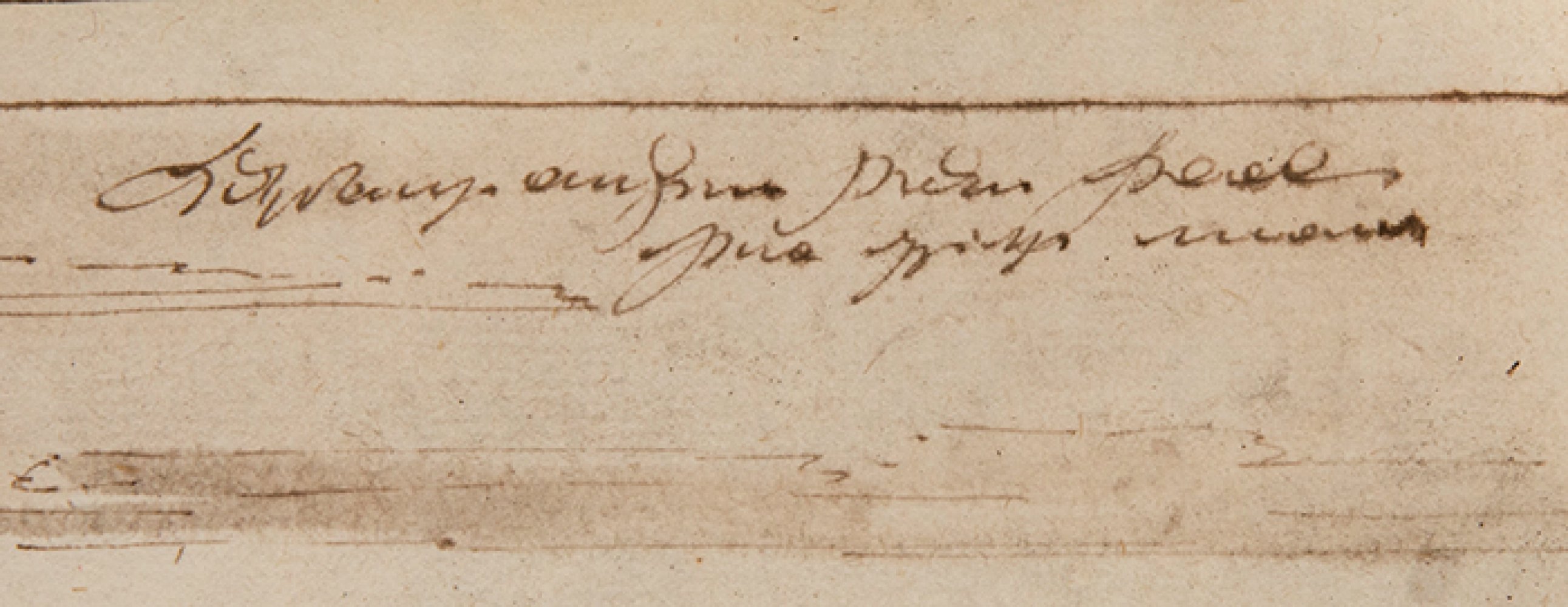37
Attributed to FRANCESCO GUARDI (Venice, 1712-1793)."View of the Arsenal of Venice".Ink on paper.With
"View of the Arsenal of Venice".
Ink on paper.
With illegible inscription.
Size: 11 x 22 cm; 25,5 x 33,5 cm (frame).
Landscape drawing showing a horizontal view of the city of Venice, specifically of the Arsenal. The scene, which is composed in the form of a frieze, shows the buildings and the typical gondolas of the city that were and are so much admired by artists. The work belongs to the genre known as veduta ("view" in Italian), which developed particularly from the Baroque period onwards, especially from the 18th century onwards, in parallel with the growing importance of the landscape genre. Within this genre, veduta is notable for its depiction of urban views, usually with a high degree of detail, as the artists worked from elaborate sketches and studies made from life. The Venetian school of veduta was particularly important and included artists such as Canaletto, Bernardo Bellotto, Francesco Guardi and others. The genre was imported from Venice to other parts of Europe, although the city of canals would always be the master of this type of art.
Francesco Guardi was born in Venice into a family of Trentino nobility. His father Domenico (born 1678) and his brothers Niccolò and Gian Antonio were also painters, and inherited the family workshop after their father's death in 1716. They probably all contributed to some of the larger commissions that were later attributed to Francesco. His sister Maria Cecilia married the leading Venetian-European painter of her day, Giovanni Battista Tiepolo, and in 1735 Guardi moved to the studio of Michele Marieschi, where he remained until 1743. His first known works date from 1738 for a parish church in Vigo d'Anuania in Trentino. During this period he worked alongside his older brother Gian Antonio. His works from this period included landscapes and compositions of figures. His early vedute paintings reveal the influence of both Canaletto and Luca Carlevarijs. Francesco Guardi's most important later works include the Doge's Feasts, a series of twelve canvases celebrating the ceremonies held in 1763 for the election of the Mocenigo de Doge Alvise IV. In his later years, Canaletto's influence on his art waned, as evidenced by the Piazzetta in the Ca' d'Oro in Venice. In about 1778, he painted the severe Holy Trinity which appears in the Sts. Peter and Paul in the parish church of Roncegno. In 1782, he was admitted to the Academy of Fine Arts in Venice. Among all the paintings attributed to Francesco and his brother Gian Antonio Guardi, the most praised work is not a landscape, but the airy sfumato Story of Tobit painted for the organ in the small Chiesa dell'Angelo San Raffaele. To quote from the Web Art Gallery:The perspective, the organised airy space, the Palladian solidity of Tiepolo ... are exchanged for a personal style of handwriting, now brilliantly calligraphic, now brilliantly cloudy.Guardi's painting style is known as pittura di tocco (by touch) for its small strokes and energetic brushstrokes. Giovanni Piazzetta and Sebastiano Ricci used this looser style of painting, and it recalls, in some religious subjects, the sfumato characteristic of Barocci's Bolognese style. In this it differs from the more linear and architecturally precise style of Canaletto's painting. This style would make Guardi's works highly appreciated by the French Impressionists a century later.
"View of the Arsenal of Venice".
Ink on paper.
With illegible inscription.
Size: 11 x 22 cm; 25,5 x 33,5 cm (frame).
Landscape drawing showing a horizontal view of the city of Venice, specifically of the Arsenal. The scene, which is composed in the form of a frieze, shows the buildings and the typical gondolas of the city that were and are so much admired by artists. The work belongs to the genre known as veduta ("view" in Italian), which developed particularly from the Baroque period onwards, especially from the 18th century onwards, in parallel with the growing importance of the landscape genre. Within this genre, veduta is notable for its depiction of urban views, usually with a high degree of detail, as the artists worked from elaborate sketches and studies made from life. The Venetian school of veduta was particularly important and included artists such as Canaletto, Bernardo Bellotto, Francesco Guardi and others. The genre was imported from Venice to other parts of Europe, although the city of canals would always be the master of this type of art.
Francesco Guardi was born in Venice into a family of Trentino nobility. His father Domenico (born 1678) and his brothers Niccolò and Gian Antonio were also painters, and inherited the family workshop after their father's death in 1716. They probably all contributed to some of the larger commissions that were later attributed to Francesco. His sister Maria Cecilia married the leading Venetian-European painter of her day, Giovanni Battista Tiepolo, and in 1735 Guardi moved to the studio of Michele Marieschi, where he remained until 1743. His first known works date from 1738 for a parish church in Vigo d'Anuania in Trentino. During this period he worked alongside his older brother Gian Antonio. His works from this period included landscapes and compositions of figures. His early vedute paintings reveal the influence of both Canaletto and Luca Carlevarijs. Francesco Guardi's most important later works include the Doge's Feasts, a series of twelve canvases celebrating the ceremonies held in 1763 for the election of the Mocenigo de Doge Alvise IV. In his later years, Canaletto's influence on his art waned, as evidenced by the Piazzetta in the Ca' d'Oro in Venice. In about 1778, he painted the severe Holy Trinity which appears in the Sts. Peter and Paul in the parish church of Roncegno. In 1782, he was admitted to the Academy of Fine Arts in Venice. Among all the paintings attributed to Francesco and his brother Gian Antonio Guardi, the most praised work is not a landscape, but the airy sfumato Story of Tobit painted for the organ in the small Chiesa dell'Angelo San Raffaele. To quote from the Web Art Gallery:The perspective, the organised airy space, the Palladian solidity of Tiepolo ... are exchanged for a personal style of handwriting, now brilliantly calligraphic, now brilliantly cloudy.Guardi's painting style is known as pittura di tocco (by touch) for its small strokes and energetic brushstrokes. Giovanni Piazzetta and Sebastiano Ricci used this looser style of painting, and it recalls, in some religious subjects, the sfumato characteristic of Barocci's Bolognese style. In this it differs from the more linear and architecturally precise style of Canaletto's painting. This style would make Guardi's works highly appreciated by the French Impressionists a century later.
26th October - Old Masters
Sale Date(s)
Venue Address
General delivery information available from the auctioneer
Setdart offers Worldwide shipping
PICK UP IN ROOM: You can come and pick up your lots in our offices (Barcelona, Madrid or Valencia). At the moment of the withdrawal, you will be able to accept the current conditions of the lot by means of a document that you will sign.
YOU CAN SEND ANOTHER PERSON TO PICK UP: This person must present a signed authorization that you can find in our web page by accessing from BUY AT SETDART- LOGISTICS-DOWNLOAD AUTHORIZATION DOCUMENT. You can also send an e-mail with the requested data in AUTHORIZATION DOCUMENT to admin@setdart.com
Important Information
25% buyer´s premium
21% buyer´s premium at www.setdart.com
Terms & Conditions
The maximum period to pay the lots is 7 working days. You can pay either via bank transfer or with credit card through our platform www.setdart.com (we only accept VISA or Mastercard).
BUYER´S PREMIUM: 22% Hammer price + 21% VAT from the buyer´s premium
If your piece has more than 100 years, our Ministry of Culture requires an export certificate in order for the piece to leave the country. Note that if the piece goes inside the EU, there is no cost for the export certificate. If the piece goes outside the EU, there is a cost for the export certificate. You can find more information in our Ministry of Culture website: https://www.culturaydeporte.gob.es/en/cultura/patrimonio/exportacionimportacion/exportacion/tasas.html
INQUIRIES: admin@setdart.com
Setdart guides you through the entire process, from the time of award to the day you receive your lot. Our logistics team will be happy to manage your transport, and will advise you on the best shipping method with professionals from the sector used to handling works of art and jewelry.
WE OFFER WORLDWIDE DOOR TO DOOR SHIPPING
PICK UP IN ROOM: You can come and pick up your lots in our offices. At the moment of the withdrawal, you will be able to accept the current conditions of the lot by means of a document that you will sign.
YOU CAN SEND ANOTHER PERSON TO PICK UP: This person must present a signed authorization that you can find in our web page by accessing from BUY AT SETDART-LOGISTICS-DOWNLOAD AUTHORIZATION DOCUMENT. You can also send an e-mail with the requested data in AUTHORIZATION DOCUMENT to admin@setdart.com
SETDART IS NOT RESPONSIBLE FOR THE STATE OF THE PARTS ONCE THEY LEAVE OUR FACILITIES. MRW SHIPMENTS: Once the payment is made, your lot will be packed for shipment, the logistics department will send you an e-mail notifying you of the day it leaves our warehouse, changes of address cannot be made after receiving this e-mail.
INSURANCE INCIDENTS: Coverage for the value of the auction up to 3000 ? per shipment, if the value of the auction is higher, Setdart will send you a quote including the additional insurance. The insurance company WILL NOT BE RESPONSIBLE FOR THE SHIPMENT THAT EXCEEDS THAT AMOUNT AND IS NOT FULLY INSURED. MRW INCIDENTS: Maximum notification 48 hours after receipt, after which the insurance company WILL NOT BE RESPONSIBLE AND NO CLAIMS WILL BE ACCEPTED.
E-MAIL LOGISTICS: logistica@setdart.com
PICK UP YOUR MESSAGES: You can send your own messaging, prior notice via e-mail that your shipment is ready, please note 3 or 4 days in advance. This type of shipment is packaged so Setdart will provide you with a quote.
EXPENSES FOR STORAGE: We inform you that if the purchased lot is not picked up within a month, you will be charged 30€ per week per lot. Setdart Online S.L., owner of the web site "setdart.com", "setdart.net" and "setdart.org", acts as a company of Spanish nationality inscribed in the Volume 36955, sheet 182, page B-293056 of the Mercantile Registry, with registered office at Calle Aragó









